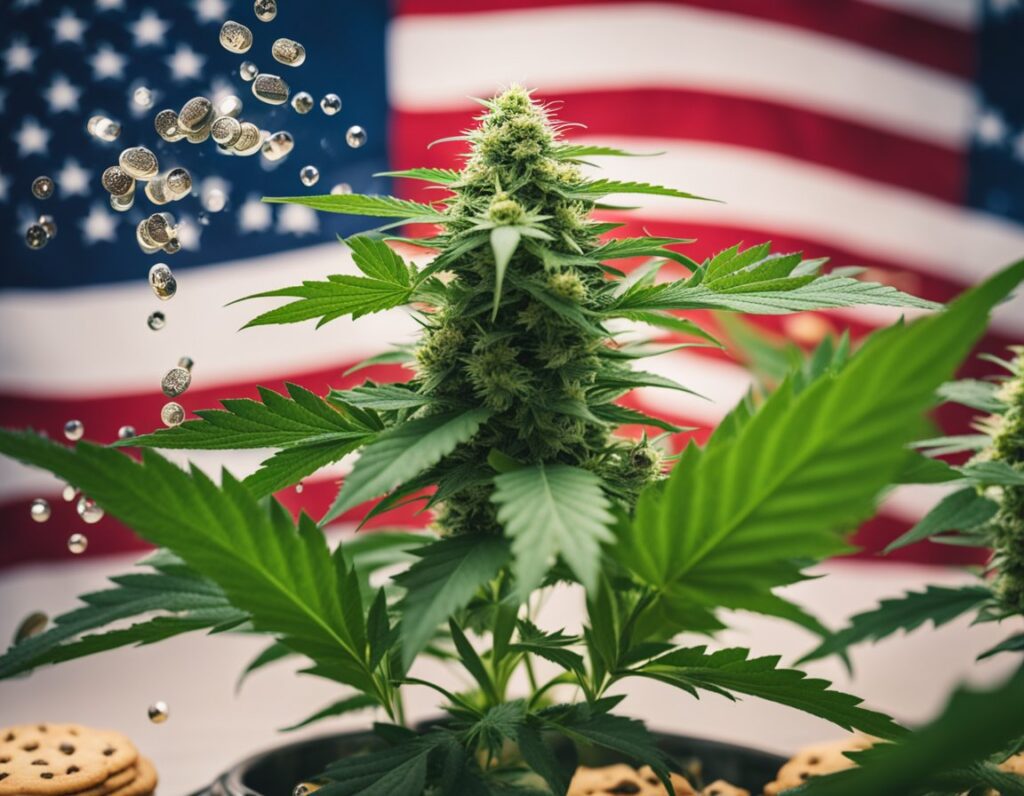
Proper watering is crucial for the health of cannabis plants, impacting photosynthesis, root development, and overall plant vitality. Knowing how to balance soil moisture correctly helps avoid common issues like overwatering and underwatering, which can stunt growth and lead to various plant health problems.
Water is vital for cannabis, acting as a medium for nutrient delivery and a key player in photosynthesis. It’s important for maintaining turgidity, which supports the plant structure. Adequate water availability allows the roots to absorb nutrients effectively, promoting robust growth. Water also facilitates the distribution of fertilizers, influencing how well your plants will thrive. Without sufficient water, nutrient deficiencies may occur, causing stunted growth and weak plants.
Achieving the correct soil moisture level is pivotal in cannabis cultivation. Too much water can suffocate roots, leading to oxygen deprivation and root rot. It’s essential to let the growing medium dry slightly between waterings to encourage root oxygenation and healthy root expansion. Monitoring soil moisture through tools like a moisture meter provides gardeners with insight to maintain the appropriate balance, ensuring the roots have constant access to required moisture without becoming waterlogged.
Cannabis plants show distinct symptoms when overwatered or underwatered. Signs of overwatering include yellowing leaves, wilting, and a musty smell from the soil. On the other hand, underwatered plants often have crispy leaves and drooping stems. Monitoring the plant and soil condition regularly enables early detection and correction of these issues. It’s crucial to adjust watering schedules based on environmental factors like humidity and temperature to maintain optimal plant health.
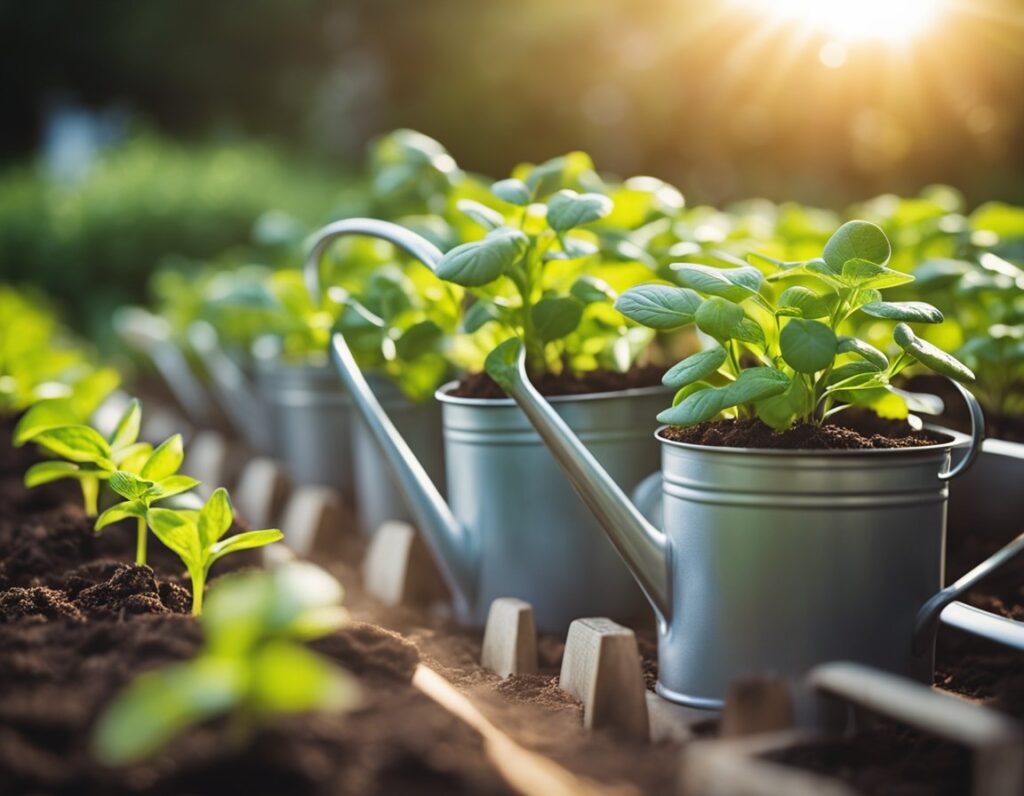
Creating an effective watering schedule is vital for growing healthy cannabis plants from seed to harvest. Key factors include environmental conditions and plant growth stages, which significantly influence the watering needs.
Watering frequency is affected by various factors such as climate, soil type, and plant stage. In warmer climates, more frequent watering is necessary to prevent soil from drying out.
Sandy soils drain quickly and require more frequent irrigation than clay soils, which retain moisture longer. During the vegetative stage, plants need consistent water to support leaf and stem development.
Consider the humidity in your growing environment. A dryer climate necessitates more frequent watering compared to a humid environment.
For seed germination, moderate and consistent moisture is crucial. Overwatering can lead to waterlogging, hindering seedling emergence. Once your plants enter the vegetative stage, support rapid growth with increased watering frequency, being mindful not to over-saturate.
During the flowering stage, reduce watering to encourage resin production. Use a reliable method such as the “knuckle test”—water when the soil feels dry an inch below the surface—to determine when watering is needed.
Always adjust your schedule based on weather patterns and feedback from the plants themselves, such as leaf drooping or discoloration, which can indicate watering issues.
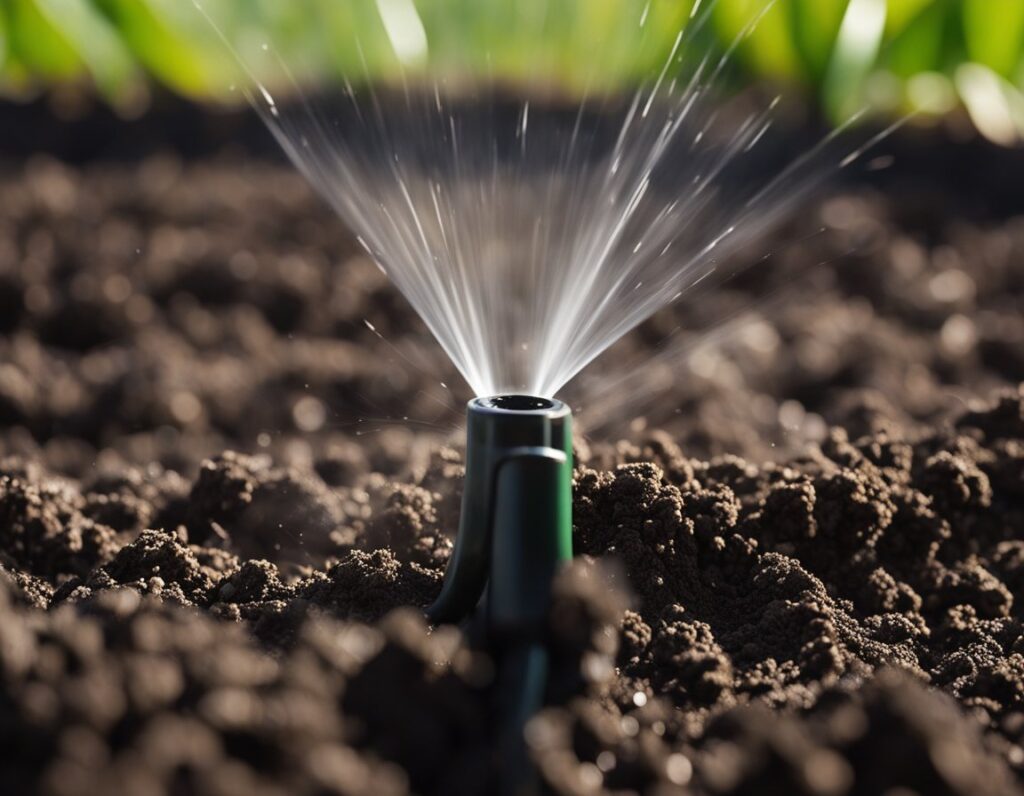
Effective management of soil and water quality is crucial for successful cannabis cultivation. Understanding soil composition and amendments, maintaining optimal pH levels, and ensuring water quality significantly impact plant health and yield.
Selecting the right soil type is essential for cannabis cultivation. Loamy soil balances sand, silt, and clay, providing excellent drainage and nutrient retention. Consider incorporating organic matter like compost to improve soil structure and enrich nutrient content.
Adding amendments such as perlite or vermiculite can enhance aeration and water retention. Pay attention to soil quality by conducting soil tests to determine nutrient levels and necessary amendments. This ensures that cannabis seeds have access to vital nutrients for growth.
Cannabis thrives in a slightly acidic to neutral pH range, typically between 6.0 and 7.0. Maintaining the correct pH is important to avoid nutrient lockout, where critical nutrients become unavailable to the plants. Regularly monitor the pH of both soil and water.
Adjusting pH can be done using products like lime or sulfur. Correct pH levels ensure efficient nutrient absorption, supporting healthy cannabis development and maximizing yield potential. Nutrient-rich solutions should match the desired pH to prevent imbalances.
Water quality directly influences cannabis growth and overall health. Hard water with high mineral content can lead to salt buildup, impairing nutrient uptake. Use a water filtration system or reverse osmosis to purify water, removing impurities and contaminants.
Check water’s pH level to ensure it complements soil conditions. This careful monitoring prevents pH swings that could stress plants. Cannabis nutrients often require specific water quality conditions, so maintaining clean and balanced water helps cannabis plants thrive.
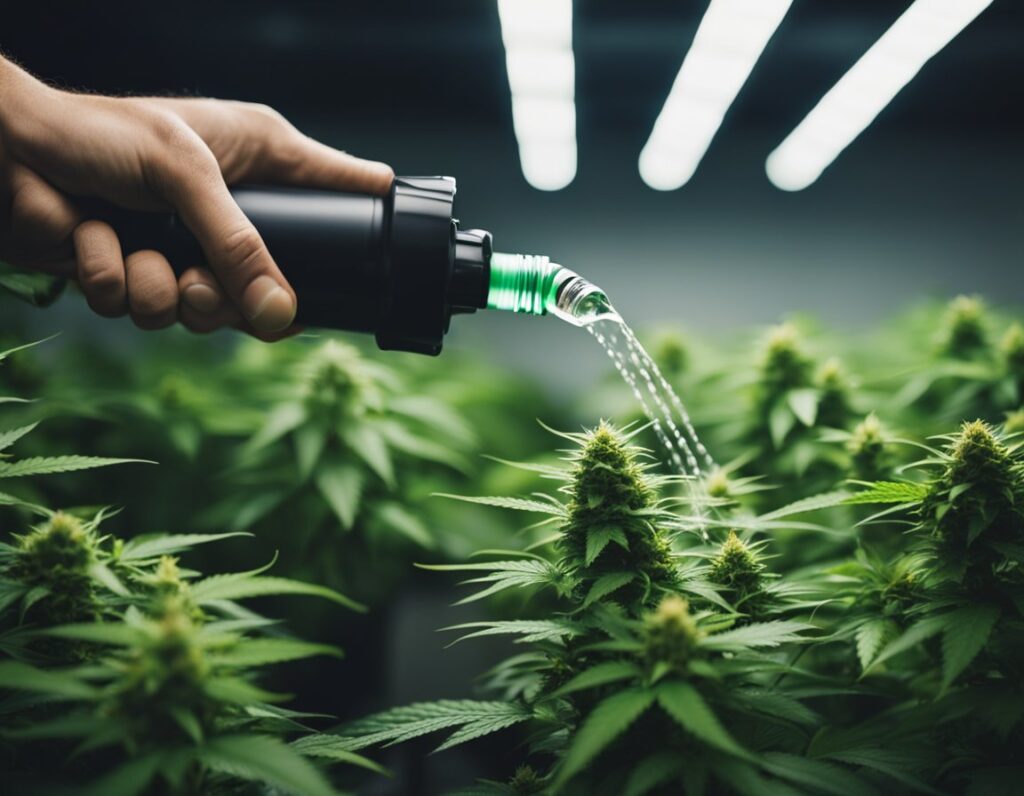
To achieve healthy cannabis plants, it’s essential to apply effective watering methods that prevent issues such as root rot and ensure optimal growth. Understanding the nuances of different techniques, as well as the role of aeration and drainage, is crucial in this endeavor.
Top watering involves applying water to the surface of the soil, allowing it to seep down through the root zone. This method ensures even moisture distribution when done slowly, using tools like a watering can with a fine rose. It’s essential to monitor the soil’s moisture content to prevent overwatering, a common cause of root rot.
In contrast, bottom watering allows the plant to draw water up from a tray or saucer beneath the pot. This technique encourages root growth as the roots stretch downward toward the moisture source. Bottom watering is particularly effective in preventing dry pockets near the bottom of pots and can help improve nutrient uptake.
Proper aeration is vital in creating an environment where roots can breathe. Using growing mediums like perlite or coco coir improves airflow and reduces the risk of compaction. This helps maintain a healthy balance of moisture and air, crucial for preventing root rot.
Drainage is equally important; ensure your pots have adequate drainage holes. This allows excess water to escape, preventing waterlogged conditions that foster fungal and bacterial growth. You can also use elevating trays to further enhance drainage and protect against standing water, which can lead to serious plant health issues.
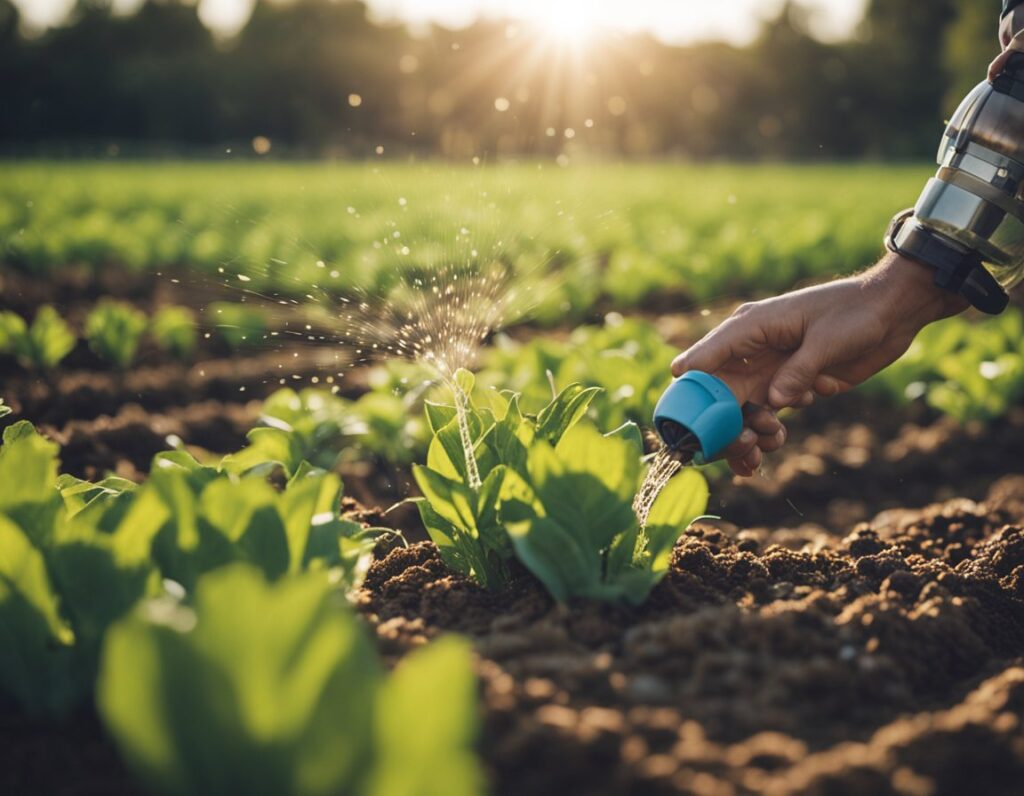
Mastering the management of environmental factors is key to successful irrigation for cannabis plants. This involves tailoring watering methods to local outdoor conditions and taking proactive steps to shield plants from environmental stress and pests.
Your cannabis plants’ watering needs are strongly influenced by outdoor conditions such as temperature and sunlight. In hot climates, you may need to increase watering frequency to counteract rapid soil evaporation. Conversely, cooler regions might require less frequent watering to prevent damping-off and root rot.
Consider the soil type and local weather patterns. Sandy soils may need water more often than clay-rich soils. Morning watering helps reduce water loss to evaporation and prepares plants to face midday heat.
Environmental stress and pests can significantly impact your cannabis plants’ health. Protect against strong winds and extreme temperature fluctuations with shelters or barriers. Implement proper spacing to reduce the risk of fungal diseases like powdery mildew and damping-off.
Combat pests by using biological controls or natural insect repellents. Monitoring and adjusting your plant’s environment will minimize transplant shock and support healthier growth. Check location factors like sunlight exposure to ensure optimal light for photosynthesis without overheating the plants.
Effectively monitoring and adjusting watering routines can make a significant difference in the growth and yield of your Cookies seeds. Critical aspects include evaluating soil moisture and plant response while also preventing and managing water-related diseases.
Stay vigilant by observing both soil and plant signals. Begin with checking soil moisture using a soil moisture meter or the “finger test.” Insert your finger a couple of inches into the soil; if it feels dry, it’s time to water.
Pay attention to your seedlings. Signs of underwatering include wilting and yellowing leaves, while overwatering might cause drooping or mold. Establish a watering routine that aligns with your plant’s needs and environmental conditions, adjusting as necessary.
Monitoring runoff is also crucial, ensuring excess water doesn’t pool around your plants. Adapt your method to prevent issues during the germination process, ensuring optimal moisture levels throughout.
Proper watering practices are vital not only for growth but also for disease prevention. Overwatering may lead to root rot or fungal infections, which can jeopardize your cannabis yield. Ensure adequate drainage in your growing medium and avoid consistently waterlogged soil to mitigate these risks.
Use mulching techniques to maintain consistent soil moisture and temperature, reducing the likelihood of fungal growth. If diseases occur, prompt identification and treatment with appropriate fungicides or adjustments in watering can resolve the problem. Seeking expert tips from agricultural professionals can further safeguard your plants’ health.
Watering cookie seedlings effectively involves understanding their specific needs at various growth stages. Other key factors include recognizing signs of overwatering, ensuring optimal lighting, and maintaining appropriate temperature and humidity levels.
During the early seedling stage, cookie seedlings require minimal water—just enough to keep the soil moist. As they grow, gradually increase the amount of water, ensuring the soil is never soggy or overly dry.
Overwatered seedlings often show yellowing leaves and a droopy appearance. The soil may feel consistently wet or soggy, which can lead to root rot. Ensure proper drainage and adjust your watering schedule if these symptoms appear.
Cookie seedlings thrive under 16-18 hours of fluorescent or LED lighting per day. This mimics their natural sunlight exposure, promoting healthy growth and development in the crucial early stages.
Maintain temperatures between 68°F and 77°F to support vigorous seedling growth. Humidity levels should range from 60% to 70% to prevent dehydration and maintain a conducive environment for initial plant development.
A healthy cookie seedling should exhibit vibrant green leaves, a firm stem, and continual growth. The plant should remain upright and show no signs of discoloration or wilting, indicating that it is receiving adequate care.
We ship and deliver world wide via USPS and various couriers.
We offer a wide range of secure and anonymous online payment options.
We care about you, our customer. Please contact us with any questions or concerns.
Find out more about the benefits of being a loyal and regular customer.
WE ARE EVERY GROWERS ONE STOP SHOP TO ACQUIRE PREMIUM CANNABIS SEEDS FOR SALE IN THE USA, CANADA AND AUSTRALIA

Farmers Lab Seeds 2024, | All Right Reserved
Seeds are sold as novelty items, souvenirs, and collectibles. They contain 0% THC. We encourage our customers to check the legislation in their Country, State, Province, and Municipality prior to purchasing items from our store. We do not provide growing information.
All seeds are sold as hemp, and lab tested under 0.3% THC. This product is not for use by or sale to persons under the age of 21. This product should be used only as directed on the label. It should not be used if you are pregnant or nursing. Consult with a physician before use if you have a serious medical condition or use prescription medications. A Doctor’s advice should be sought before using this and any supplemental dietary product. All trademarks and copyrights are property of their respective owners and are not affiliated with nor do they endorse this product.
These statements have not been evaluated by the FDA. This product is not intended to diagnose, treat, cure or prevent any disease. Individual weight loss results will vary. By using this site, you agree to follow the Privacy Policy and all Terms & Conditions printed on this site. Void Where Prohibited by Law.